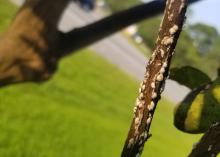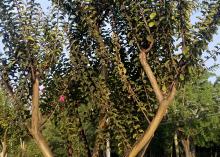Information Possibly Outdated
The information presented on this page was originally released on September 9, 2019. It may not be outdated, but please search our site for more current information. If you plan to quote or reference this information in a publication, please check with the Extension specialist or author before proceeding.
Crape myrtle bark scale remain landscape problem
This weekend while driving in my hometown of Ocean Springs, I looked at the crape myrtles planted in the median all along Highway 90. I noticed that most of the trees had a dark cast to them, even on a bright, sunny morning.
I knew immediately what I was observing: crape myrtle bark scale, or CMBS.
I started thinking how we have come a long way -- and not in a good sense -- since I first found CMBS in a commercial crape myrtle planting along Highway 90 in the spring of 2015. By the fall of that year, CMBS could be found in scattered crape myrtles along the highway median.
Fast forward to fall 2019: CMBS can be found along the entire five-plus miles of crape myrtle median planting in Ocean Springs.
Crape myrtle bark scale is a relatively new insect pest that was first reported north of Dallas, Texas, in 2004. Since then it has spread across the Southeast.
The CMBS appear as white or gray encrusted waxy spots around pruning cuts and in the crotches of branches. Underneath the waxy coating, the scale appear to be pink, and larger specimens will ooze a pink liquid when squished. Infected trees also have numerous small, pink eggs and crawlers ready for further expansion.
CMBS populations can reach prodigious numbers, with Highway 90 in Ocean Springs being a prime example. It’s quite common to observe heavily infested trees with entire branches and limbs completely caked with CMBS.
During the course of feeding on the trees, crape myrtle bark scale exude mass quantities of excrement, which is called “honeydew” because of its high sugar content. This honeydew rains down on everything below -- leaves, branches, twigs, etc.
You may have observed this honeydew rain by parking your car under trees and seeing the little dots on the windshield. Walking under trees with really heavy infestations can feel like walking in a fine, misting rain.
While you may not initially see the small scale, you will see the sooty mold. Sooty mold, which is a group of indigenous fungi, starts to grow on the honeydew and turns everything black.
The individual crape myrtle trees will not die from a CMBS infestation, but they lose their beautiful appearance in the same way as improper crape myrtle pruning, or “myrtlation,” destroys the appealing architecture of the trees.
Now that you know the symptoms exhibited by crape myrtles with CMBS, you may be wondering if control is possible.
CMBS have some insect predators, but these bugs aren’t a reliable control method. One is a lady beetle I’ve observed in association with CMBS. Called a twice-stabbed lady beetle, it has a black shell with two prominent, bright-red spots.
Gardeners can apply systemic insecticides as drenches to the plant root zone during May and July. These systemic insecticides include dinotefuran and imidacloprid. Allow several weeks for these to work because they must spread through the plant.
One way to possibly determine if the systemic insecticides are working is related to the fact that crape myrtles shed their bark in the fall. After the bark has been shed, you can look for signs of CMBS, whether the insects themselves or decreased sooty mold.
For more information on CMBS, see the Mississippi State University Extension Service Publication 2938, “Crape Myrtle Bark Scale Identification and Control.”




